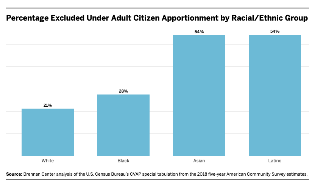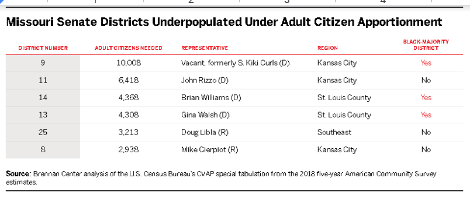This was written by Alice, one of our student interns. The opinions expressed herein do not reflect those of Civitas other than respect for the value of open dialogue.
On November 3, 2020, Amendment 3 passed 51.01% to 48.99% in Missouri (Missouri Amendment 3, Redistricting Process and Criteria, Lobbying, and Campaign Finance Amendment, 2020). But what many Missourians didn’t understand was that the passage of Amendment 3 in the Missouri Constitution will significantly impact the electoral process by changing redistricting procedures that will ultimately result in the loss of representation for people of color and Democrats.
Amendment 3 has three main points, all of which concern the election process. Amendment 3 seeks to “Ban gifts from paid lobbyists to legislators and their employees,” further limit campaign contributions, and change the redistricting process and criteria (2020 Ballot Measures, 2020). Essentially, the amendment places exact limits on redistricting and campaign finance. More specifically, the threshold for lobbyist gifts was changed for $5 to $0 (Missouri Amendment 3, Redistricting Process and Criteria, Lobbying, and Campaign Finance Amendment, 2020). The campaign contribution limit for state senate campaigns was also lowered, from $2,500 to $2,400 (Missouri Amendment 3, Redistricting Process and Criteria, Lobbying, and Campaign Finance Amendment, 2020). The bulk of the issue however, is the altered criteria for the redistricting process—this is key. Another important detail about the amendment itself is that its language was actually challenged in court and found to be misleading, which led to a change in wording for the amendment before the election (Missouri Amendment 3, Redistricting Process and Criteria, Lobbying, and Campaign Finance Amendment , 2020). The history of Missouri’s Amendment 3, however, is not as clear. Amendment 3 is related to a previous Missouri constitutional amendment, Amendment 1, which was passed in 2018 with support from the organization Clean Missouri, though it adamantly opposes Amendment 3. Clean Missouri helped pass Amendment 1 in 2018 after a clear notion from voters that they were unsatisfied with the state’s current legislative redistricting system, as well as limits on campaign finance and lobbyist gifts (Hemphill, 2020). However, Amendment 3 addresses the same issues as Amendment 1, but changes the redistricting system in a different way—eliminating nonpartisan demographers and replacing them with a bipartisan commission (Hemphill, 2020). Not only that, but Clean Missouri advocates, who fight for fair maps in Missouri elections, are urging a “no” vote on Amendment 3, saying it’s “a deceptive plan to rig the maps” (Hemphill, 2020).
Clean Missouri’s claims are completely valid. After all, the redistricting process under Amendment 3 severely limits the number of people counted for purposes of representation; up to ¼ of Missourians would not be counted (Gerrymandering Away Missouri’s Future, 2021). To be clear about who is behind the drawing of electoral maps under Amendment 3, note the following language from the amendment: “responsibility for drawing state legislative districts from the Nonpartisan State Demographer to Governor-appointed bipartisan commissions” (2020 Ballot Measures, 2020). However, because of the history of deadlock and lack of structural incentives for partisan commissioners to agree, it is likely that a six-judge panel will almost always be drawing the state’s legislative districts (Rudensky, Y., & Limon, G., 2021). The second change, and perhaps the most significant, is the change in language when referring to who is counted for purposes of representation. The explicit command of “total population” being counted is removed and replaced with the command to draw the districts on the basis of “one person, one vote” (Rudensky, Y., & Limon, G., 2021). It is this provision that accounts for the limits on who is counted for purposes of representation. The unclear language allows for Republicans in the state legislature to manipulate who is counted for purposes of representation. In a report from the Brennan Center for Justice, they concluded that, “Although ‘one person, one vote’ in the legal context has traditionally been understood to require counting all persons, the proponents of Amendment 3 have argued that this language change allows the commissions to ignore children and noncitizens when drawing district boundaries” (Rudensky, Y., & Limon, G., 2021). The ambiguity of the “one person, one vote” principle is clearly supported. For example, in a journal article from the Michigan Law review, the author, Grant M. Hayden, writes, “Despite this record of success, one of the most important and least controversial aspects of the right to vote – the one person, one vote principle – has never been adequately theorized.” (Hayden, 2003) The ignoring of children and non-citizens when drawing the maps would significantly change the makeup of the Missouri Grand Assembly, “Given Missouri’s current population, each state senate and house district should have roughly 179,000 and 37,500 people, respectively, when lines are redrawn in 2021. But under a switch to adult citizen apportionment, each senate and house seat would need to have 135,000 and 28,000 adult citizens, with no regard for the number of children or noncitizens residing within each district” (Gerrymandering Away Missouri’s Future, 2021). It’s important to note that this conflicts with every other US state (Rudensky, Y., & Limon, G., 2021). There is no definitive answer as to whether you can redistrict based on eligible voters (adult citizens) instead of the total population, “That open question could be one of the big fights of this decade,” says Michael Li, a redistricting expert who is a senior counsel for the Brennan Center’s Democracy Program (Wang, 2020). Since children and non-citizens are not distributed evenly across the state, those who live in districts with more children and non-citizens will have less representation. (Gerrymandering Away Missouri’s Future, 2021) Those who voted for Amendment 3, however, could not have known this. The language in the Amendment was misleading and confusing, to the point where simply reading the description means nothing without context.
Not only does Amendment 3 completely transform the process and rules by which redistricting takes place, there is also a racial component. Amendment 3 disproportionately targets them racial minorities in order to limit their representation in government. The unquestionably misleading wording in Amendment 3 allows for minorities to go uncounted. “Only 21 percent of Missouri’s white population would go uncounted. By contrast, 28 percent of Missouri’s Black population, 54 percent of its Asian population, and 54 percent of its Latino population would be erased when district lines are drawn.” (Gerrymandering Away Missouri’s Future, 2021) Because of the minorities going disproportionately uncounted, majority Black districts need more adult citizens to be counted — which in turn dilutes the racial majority and leads to less minority representation in Missouri government. It’s no coincidence, therefore, that the two largest urban areas (STL and Kansas City) would lose the most representation. (Gerrymandering Away Missouri’s Future, 2021) “Three of the four majority-Black senate districts in Missouri would need additional adult citizens, making it harder for communities of color to maintain their current level of political influence in these and surrounding districts.” (Gerrymandering Away Missouri’s Future, 2021) “Senate districts 9, 13, and 14 would be three of the four most underpopulated districts under adult citizen apportionment. They are also three of the four majority-Black districts in Missouri, each of which has sent Black representatives to the state capital. Collectively, these districts currently represent 42 percent of the state’s Black population. Likewise, Districts 9 and 11 have the two highest Latino populations among the state’s senate districts.” (Gerrymandering Away Missouri’s Future, 2021) Limiting representation will “disproportionately harm Black, Latino, and Asian communities.” and weakens protections for communities of color. (Rudensky, Y., & Limon, G., 2021) In short, Amendment 3 will further ensure the discrimination and disparities that Black Missourians face daily. “Missouri’s Black communities have endured a long and unbroken legacy of discrimination and face disparities in income, education, housing, health, and other key equity indicators when compared to their white counterparts. Limiting representation to adult citizens would likely compound and exacerbate these inequalities, deepening existing divisions.” (Gerrymandering Away Missouri’s Future, 2021) Clearly, this shift from total population to adult citizen apportionment is advantageous for non-hispanic whites, (Gerrymandering Away Missouri’s Future, 2021) which begs the question: which party benefits from limiting the representation of people of color?
Yep, Republicans. Given the racist undertones of the amendment, it is unsurprising that Democrats (who are consistently backed by racial minorities) are hurt as well. Amendment 3 helps Republicans gain control of the Missouri government, and consequently has been consistently backed by Republicans and conservative groups. The Amendment itself was drafted by the same law firm that had previously represented the National Republican Redistricting Trust. (Gerrymandering Away Missouri’s Future, 2021) Most upsetting of all, however, are a national conservative operative’s (Thomas Hofeller) memos that were released, revealing a scheme by certain Republican donors and operatives to, “encourage states to make a ‘radical departure’ from total population to adult citizen apportionment, arguing that it would be ‘advantageous to Republicans and non-Hispanic whites.’” (Gerrymandering Away Missouri’s Future, 2021) Not only is the amendment so clearly advantageous to one party, it will also result in fewer gerrymandering safeguards, given that it, “relaxes its partisan fairness requirement, and deemphasizes drawing politically competitive districts.” (Rudensky, Y., & Limon, G., 2021) Essentially, the amendment results in less protection against gerrymandering, and gives Missourians less of an ability to challenge bad maps in court. (Rudensky, Y., & Limon, G., 2021) So, it should come as no surprise that the shift to adult citizen representation is consequently backed by virtually all Republicans. All supporters of Amendment 3 were Republican, opponents were overwhelmingly Democratic, but some Republicans as well.
Amendment 3 clearly benefits Conservatives and white Missourians over everyone else. The vague and ambiguous language allows for dangerous interpretations that will open the door for more gerrymandering and the loss of representation for minorities. Limiting the representation of certain groups, and simply not counting people is a technique that has been used before to help the political elite maintain control. For instance, during the Civil War, there “were efforts by elites, in both the South and North, to solidify their hold on political power by cutting a portion of the mass public out of the electoral process (Burnham 1965)” (Engstorm, 2013) This utterly undemocratic and unconstitutional Amendment has no place in the 21st century.
Reference Page
Engstrom, E. (2013). Gerrymandering and the Future of American Politics. In Partisan
Gerrymandering and the Construction of American Democracy (pp. 191-206). Ann
Arbor: University of Michigan Press. doi:10.2307/j.ctt1gk086k.13
Hayden, G. (2003). The False Promise of One Person, One Vote. Michigan Law Review, 102(2),
213-267. doi:10.2307/3595382
Hemphill, E. (n.d.). Pro & Con: Amendment 3 Has Missouri Voters Back To The Drawing Board
On Legislative Districts. St. Louis Public Radio. https://news.stlpublicradio.org/show/st-louis-on-the-air/2020-10-20/pro-con-amendment-3-has-missouri-voters-back-to-the-drawing-board-on-legislative-districts.
Missouri Amendment 3, Redistricting Process and Criteria, Lobbying, and Campaign Finance
Amendment (2020). Ballotpedia. (n.d.). https://ballotpedia.org/Missouri_Amendment_3,_Redistricting_Process_and_Criteria,_Lobbying,_and_Campaign_Finance_Amendment_(2020).
Missouri Secretary of State – IT. (n.d.). 2020 Ballot Measures. Missouri State Seal.
https://www.sos.mo.gov/elections/petitions/2020BallotMeasures.
Rudensky, Y., & Limon, G. (2021, May 4). Missouri Amendment 3 Passed, What Does that
Mean for Redistricting? Brennan Center for Justice. https://www.brennancenter.org/our-
work/research-reports/missouri-amendment-3-passed-what-does-mean-redistricting.
Wang, H. L. (2020, November 6). A National Fight Over Who Is Counted In Voting Districts
May Arise From Missouri. NPR. https://www.npr.org/2020/11/06/931908064/a-national-fight-over-who-is-counted-in-voting-districts-may-arise-from-missouri.
216, & 8610. (2021, May 4). Gerrymandering Away Missouri’s Future. Brennan Center for
Justice. https://www.brennancenter.org/our-work/research-reports/gerrymandering-away
-missouris-future.





Pingback:Index of 2021 Intern Student Blog Posts - CIVITAS-STL